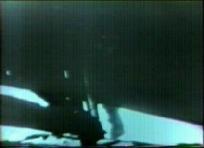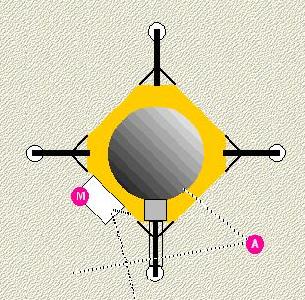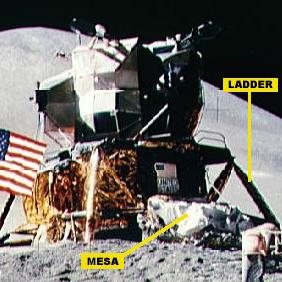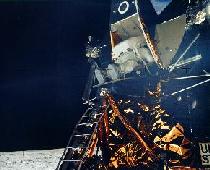television camera







|
 THE EAGLE HAS LANDED, NASA (1969) |
The television camera was packed aboard the Modular Equipment Stowage Assembly (MESA). This was a bay of equipment strapped to the side of the lunar module and wrapped in insulation. It contained the astronauts' tools and supplies for their surface mission. Once on the surface it could be lowered like a drawbridge.
Because it was a prime publicity moment, NASA had to figure out a way to televise the first footsteps on the moon. They did this by arranging for Neil Armstrong to be able to open the MESA while still on the ladder by means of a lanyard connected to the MESA latch.
Once opened automatically, the television camera on a special strut would spring into place and begin transmitting. It was pre-aimed at the ladder. The Apollo 11 press kit distributed in 1969 even contains a diagram showing journalists what they should expect to see with this television camera.
 CLAVIUS |
The feature marked "M" is the MESA located on the right hand side of the lunar module. The dotted lines show the approximate field of view of the television camera.
Armstrong appears to be standing near the spot marked "A" in order to take the picture at top. The MESA and television camera are around the other side, out of Armstrong's field of view. The lander strut would probably have obscured any view of the MESA from his point of view.
At a later point in the mission, the astronauts removed the television camera from the MESA mount and set it up some distance away to record their activities.
Below is a photograph from Apollo 15 showing the MESA in the lowered position, and indicating the lunar module's ladder in relation to that equipment.
 NASA: AS15-88-11865 |

 A television camera
recorded Neil Armstrong descending the lunar module's ladder and
stepping onto the lunar surface. Why can't we see that television
camera in pictures like the one on the left?
A television camera
recorded Neil Armstrong descending the lunar module's ladder and
stepping onto the lunar surface. Why can't we see that television
camera in pictures like the one on the left?
